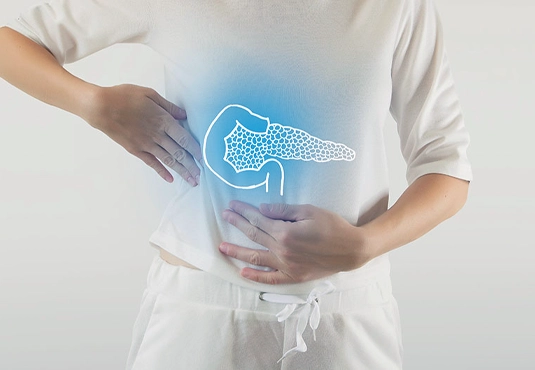
The most common cystic lesions in the pancreas are serous and mucinous cysts. It is important to distinguish them from each other in terms of the treatment to be applied. While serous cysts are completely benign and do not require any treatment, there is a risk of developing cancer ranging from 10-20% in mucinous cysts, which are more common in middle-aged women.
Depending on their size and location in the pancreas, these cysts can cause complaints such as abdominal pain, nausea, vomiting, and weight loss.
These cysts, most of which are located in the body and tail of the pancreas and can reach 5-25 cm in length, should be removed due to the risk of developing cancer. This procedure is also performed by surgical intervention.
Contrast-enhanced CT, endoscopic ultrasound and MR-MRCP are suitable imaging modalities.
Biopsy can be performed under endoscopic ultrasound. Although it is very difficult to remove a piece of tissue, it is possible to obtain information about whether the fluid is serous or mucinous by aspiration of the fluid. In addition, the levels of tumor markers such as CEA, Ca 19.9, amylase level and cytological examination in the fluid can also provide additional information.
It occurs when the fluid with high amylase content leaking from the pancreatic tissue with impaired integrity in patients with pancreatitis turns into a cystic accumulation with the protection of the surrounding organs. While small cysts may disappear during follow-up, large-diameter cysts may regress in diameter during follow-up and decrease to a size that does not require any treatment. However, large cysts may require drainage if they also show clinical symptoms. This drainage can be into the stomach or into the intestine with surgery.
IPMN stands for 'Intraductal Papillary Mucinous Neoplasia'. It is about the secretory ducts in the pancreas. Bubble (papillary) structures grow within these ducts. These structures secrete mucin. Mucin is a transparent liquid with a sticky consistency, like egg white. Most importantly, these structures are pathologically new tissue formation (neoplasia),which means that they tend to grow anarchically, that is, to become cancerous. They belong to the group of mucinous cysts. The principles of treatment there also apply to them. The risk of developing cancer in the type originating from the main canal of the pancreas (main branch IPMN) is more risky in terms of cancer development than in the type originating from the side branches (sub-branch IPMN).
It is the surgical removal of the diseased part (especially in the main branch IPMN). Sometimes it may be necessary to remove the entire pancreas.




